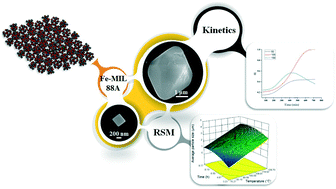Preparation, optimization and evolution of the kinetic mechanism of an Fe-MIL-88A metal–organic framework
Abstract
Fe-MIL-88A is a member of the MIL family of metal–organic frameworks that has been proved efficient in many applications. The flexible porous structure and biocompatibility are its most featured properties. In order to properly put this material into use, it is important to have detailed knowledge on its crystallization process, both kinetically and experimentally. In this paper the modulator-assisted solvothermal formation of the MOF was assessed systematically through a response surface methodology design of experiments and the variations in the average particle size were modeled. The particle formation was found to be seriously affected by temperature, leading to an increase in the average particle size. The morphology of the products and their particle sizes were observed using FESEM and two distinct morphologies of cubic and diamond-like particles were clearly distinguished. The product was further characterized using FTIR spectroscopy and XRD analysis. The kinetics of the crystallization process of Fe-MIL-88A was studied using crystallization curves. Both the nucleation and growth rate constants increased with temperature. The MOF nucleation was found to be autocatalytic and it was the rate controlling stage of the whole formation process.



 Please wait while we load your content...
Please wait while we load your content...